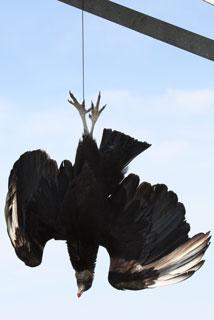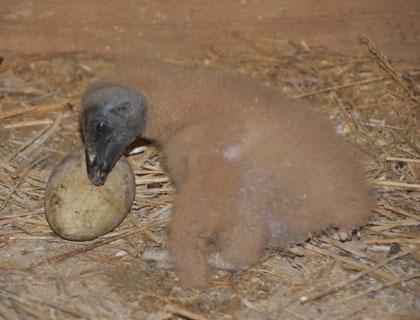How to Deter Vultures
Vulture Information:
Click on the following links to learn more:
- Vultures are a federally protected by the Migratory Bird Treaty Act of 1918. This means that the birds, their nests, and eggs cannot be killed or destroyed without a Migratory Bird Depredation Permit (see permit information below).
- It is perfectly legal to harass vultures and use effigies to scare them away.
- Harassment is done to make the vultures feel unsafe or uncomfortable in an area, which may cause them to leave and not return.
- Techniques to disturb vultures include loud noises (i.e., blow horns), spraying with a garden hose, or using pyrotechnics may be required. Other effective tools include the use of non-lethal shooting and propane cannons, especially in large pasture settings.
- An effigy is a dead or fake dead animal that is hung in an area to deter that specific species from congregating.
- Effigies are extremely effective at deterring black vultures from using an area if displayed properly.
- Effigies need to be hung high enough to be seen from a distance.
- Effigies should be displayed by hanging the bird upside down by their feet with the wings spread to be most effective (See Figure 2).
Protecting Herds
- Cultural practices such as moving livestock to a pasture that allows you to keep a close eye on them during birthing
-
The most efficient manner to decrease the likelihood of black vulture affecting your herd is to place a vulture effigy (Figure 2) around calving area

Figure 2. black vulture effigy When you have obtained an effigy you want to make it highly visible to vultures in the area you would like to protect.
- One of the best methods is to hang the vulture by its feet using a rope and suspend it in the air making it visible from a distance.
- Hang it at a high point that is visible from all sides directly adjacent to, or in, the calving pasture. It is helpful to concentrate calving operations in a pasture directly adjacent to the effigy to maximize its effectiveness.
- After you believe the vultures are no longer a threat, or you are no longer expecting newborn livestock, you may want to place any non-plastic (i.e., birds taken by a damage permit) effigies in a plastic bag and freeze it so that if can be used again in the future if needed.
Disturbing Roosts
-

Figure 3. Black vulture nest Roosts can be disturbed as long as they are not nesting or have young (Figure 3). It may be necessary to inspect a roost area for signs of an active nest (eggs or chicks) in late spring and early summer prior to starting a harassment program.
- Roost disturbances should occur around ½ hour prior to sunset till ½ hour after sunset and should be completed over multiple consecutive days to increase the probability of successfully making the birds permanently leave the roost. With larger roosts harassment may need to be continued for upwards of 7-14 days. Even if you are successful in causing the birds to leave the area they may return several weeks or months later and harassment will have to occur again.
- Since harassment efforts do require loud noises, there are potential legal implications and also for the surrounding community. Prior to beginning harassment, especially those that involve any form of pyrotechnics, local authorities should be contacted to ensure compliance with any local ordinances.
- You can also use an effigy to disrupt a vulture roost by hanging it as close to the roost as possible.
Damage Permits
- Obtaining a permit to take black vultures is required as they are a protected species and are obtained through U.S. Fish and Wildlife Service.
- No state-level permits are required in Kentucky as long as a federal permit was obtained.
- Kentucky Farm Bureau has maintained the ability to issue black vulture damage sub-permits to livestock producers experiencing vulture issues. These permits allow some take of vultures to help alleviate damage issues. In order to access these sub-permits you should reach out to the Kentucky Farm Bureau as they have their own individual procedures as the coordinator of the permits. Obtaining a permit from the Kentucky Farm Bureau is the most efficient manner to obtain a permit at this time. To do so contact them as soon as the problem exists in order to reduce risk of multiple livestock losses. Directions/Contact information is found here.
- Individuals can also apply to obtain permits directly from the U.S. Fish and Wildlife Service, however this process takes time and would not allow for a quick remedy of any problems that are currently occurring. You will also need to contact USDA Wildlife Services to obtain a WS Form 37 to accompany your USFWS permit application.
- If you obtain a damage permit and take a vulture, immediately use that vulture as an effigy in the area you would like to protect. Simply hang it by a rope from somewhere that it is clearly visible from a distance (i.e., a tree branch). This will increase your chances of keeping vultures out of the area for an extended period of time.
Disposing of Dead Livestock
When a depredation event occurs or just when livestock succumb to any other form of mortality, disposing of dead livestock correctly can have substantial benefits for deterring both future vulture and other wildlife-related issues. Decreasing the amount of time the carcass can be found by vultures and other predators will lower the risks of them frequenting the area. The laws and regulations regarding disposal and composting of dead animals specific to Kentucky can be found at: http://www.kyagr.com/statevet/animal-disposal-and-rendering.html.
A list of renderers that will come and pick up dead animals can be found here.
Vulture Effigy Directions
Download a Black Vulture Effigy Directions publication.
Download publication